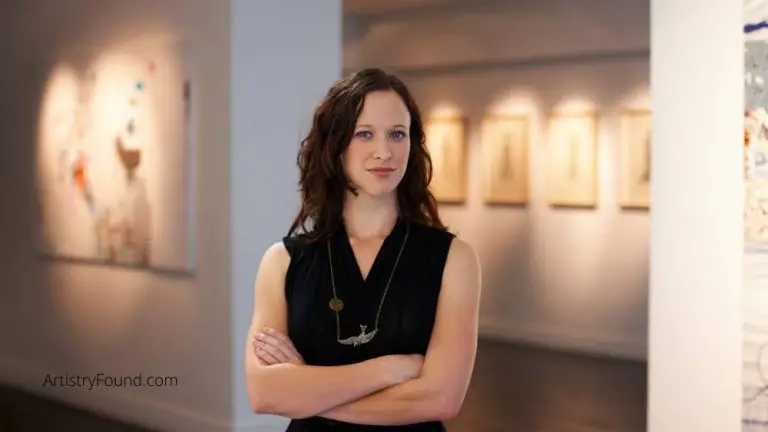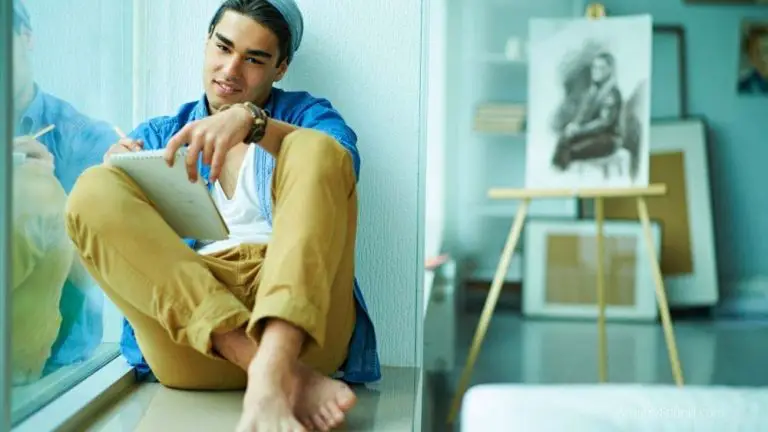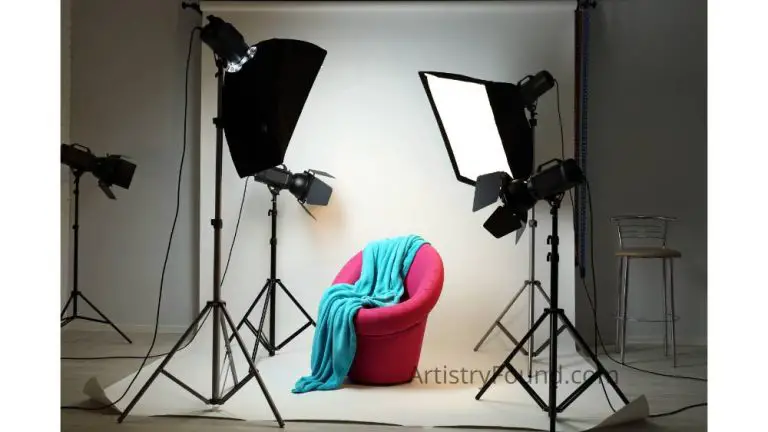Here’s How Much an Art Teacher Makes (Annual Salary)
Being an art teacher is an attractive career option on the surface, but it’s hard to know exactly what it involves and whether or not you can make a good living teaching art. So first you’ll want to know, how much does an art teacher make?
Art teachers earn on average $46,000 a year. This is going to vary significantly in either direction based on qualifications and experience. An art teacher’s salary will also depend greatly on whether one teaches art at a private school, public school, or university.
In this article, we’ll look at all the factors that determine an art teacher’s salary, and also what being an art teacher involves on a daily basis. In addition, I’ll talk about the skills and attributes needed to become a successful art teacher and what is required to get those top salaries.
Average Art Teachers Salaries (Publically Available Data)

(This article may contain affiliate links and I may earn a commission if you make a purchase)
According to salary tracking websites, art teachers can expect to make an average base salary of $46,351.
The range on payscale.com starts at $32,000 and goes up to $70,000. This doesn’t include bonuses or benefits and is pretax.
This average salary range will be impacted by the number of years of teaching experience, and you can expect to stay within the $35,000 to $45,000 range during the first ten years on the job.
Higher levels of art education or experience will generally allow for a higher art teacher salary to be achieved. Having a Master’s Degree or higher in certain specialties will be very useful for career progression.
This is true even at the elementary vs. high school level, as high school art teachers are expected to be certified in a specific art field, whereas the same does not apply to an elementary art teacher.
The highest paying states are New York, California, Massachusetts, New Jersey, and Connecticut. Looking forward, California and Texas offer the best conditions in general.
Benefits of Being an Art Teacher
States compete with each other to attract the best teachers, so the levels of benefits and advantages will vary quite significantly. This is also true for the ability of large urban areas to have bigger budgets to allocate towards teacher salaries.
However, at a minimum, you can expect insurance for your entire family, including medical, dental, and vision coverage.
Public schools set their salaries via teachers’ unions which bargain for the highest rates they can. A school district’s agreement with the teachers union will also decide the number of hours worked, expectations, and many other conditions of employment.
Private schools will instead form their own policies in regards to teachers’ salaries. However, given the costs of running a private school, the fees collected will not cover all the costs of running the school. This means that private schools must rely on charitable donations to make up the difference.
For a well-endowed school, this can mean they will offer higher salaries than public schools, but these schools are not too easy to find, and the competition to become a teacher at the school will be high.
One of the biggest motivators behind becoming an art teacher is to be involved with students. Art helps people find out more about themselves, giving you an option to be fully involved with the positive development of a student.
What Does an Art Teacher’s Job Involve?
An art teacher is almost always based in a school environment, with art classes being taught to all ages. However, there are art teaching positions available outside the school system as well.
Teaching Art in Schools
Your daily tasks teaching art in a school environment will be somewhat dependent on what education level you’re instructing. The following are the general art teaching positions that schools are looking for:
- preschool teacher
- elementary school teacher
- middle school teacher (aka secondary school teacher)
- high school teacher
- undergraduate university teacher
- graduate school teacher
While each of these teaching positions may be quite different in some respect due to the ages of the students, there are some commonalities in the descriptions of art teacher roles to give you an idea of what a day in the life of teaching art in a school involves.
These include working with materials and mediums such as fine art, clay, architecture, painting, arts and crafts, photography, and multidisciplinary art.
Being an art teacher is multidisciplinary itself, with many art teacher job advertisements including music and food preparation as other possible roles. The rise in the use of computers and technology to create and view art also means literacy in this area will be highly regarded.
Familiarity with how to use canvases, clay, paints, paper, textiles, and dyes and teaching their usage to students will be the main focus.

However, basic art skills are not enough to be even an average art teacher. You’ll also need the ability to explain the relationship of art to culture, plus you’ll need to perform the critical assessment of works of art and provide constructive criticism in a way that encourages your students.
One of your primary aims is to get your pupils to value and develop their creativity. This is based upon encouraging imagination as well as practical skills to engage with a wide variety of mediums, including painting, drawing, sculpture, digital design, photography, and textiles.
Identifying a student’s motivations and triggers to unleash their creativity is not easily learned via an art history exam or experience sculpting.
This skill will more likely come from experience working with many students and trying different strategies, as well as being abreast of the latest research.
You’ll also help foster and develop people’s appreciation of aesthetic and cultural values, as well as introduce the topics of critical thinking around subjective and objective aspects of art.
You will also have certain expectations around school life in your role as an art teacher. These may include tasks like supervision during lunchtimes and egress (when school is out for the day). The other aspects like faculty and parent-teacher meetings will also form an important part of the role.
Teaching Art Outside of a School Environment
Outside the school system, there are local community groups or art centers that cater to adults. Content is similar but without the administration and the before and after-school requirements associated with working in a public or private school.
This also opens the possibility of being able to teach an art specialty rather than following a specific school curriculum.
What Qualifications Does an Art Teacher Need?
Generally, most art teaching positions will require a bachelor’s degree or higher in the arts at a minimum. These degrees tend to focus on having extensive knowledge of art history on top of painting, sculpting, or other artistic skills.
Such degree programs will require this knowledge and skill to be demonstrated via a portfolio showcasing personal ability in the arts.
In addition, a teaching certification must also be earned to comply with whatever the local state rules are. This last component is vital as you are required to teach certain concepts, knowledge, or other abstract items to students who learn through a variety of different methods.
Along with these recognized requirements and qualifications, being an art teacher will also involve many soft skills. These skills will include things like communication, leadership, problem-solving, and teamwork, among others.
Proving that you have the complete skill set will need to be demonstrated via engagement in leadership positions, community organizing, or similar.
These soft skills are best showcased via examples on your curriculum vitae (CV), and through expanding on them in the interview process.
Art classes are likely to be quite large, so you’ll need to gain experience in effectively controlling and communicating with large groups that may have varying interest levels and engagement.
This will require strong verbal communication skills combined with adaptability and flexibility. Art lessons do not always go as planned, in fact, the creative essence of art in one sense calls for nonconformity and originality.
Part of the qualification process for becoming an art teacher is based on learning teaching methodologies. In addition, you have to learn how to drive engagement and participation, meet the needs of your students, provide clear instruction and be consistent with expectations.
You will have to focus on student-centered exercises and venture outside the bubble of art and the art world due to its insular nature. It’s all well and good to have spent years focusing on your own artwork and designs, but as a teacher, you have to now focus on leading others.
Another aspect is encouraging positive relationships and group work to expose students to their peers’ ideas, approaches, and techniques. This is a vital part of art and learning.
Problem-solving and art may not seem to be related, but in fact, problem-solving is at the heart of art, as artists are always trying to figure out ways to express complex ideas or thoughts through the medium of art.
What constitutes art or artwork is extremely broad, with new variations on old techniques or resurrections of old styles happening constantly. As a result, even disciplines like photography and using graphic imaging will be sought-after skills.
This means you need to keep on top of what is happening and ensure your inventory of craft materials and knowledge is sufficient for what you need. Making sure you know how to keep to a supply budget will be a critical skill for maintaining your position.
Art teachers also need to follow the other basics of teaching, including assigning homework, projects and following up with students to evaluate their progress. This is best demonstrated through a previous position that involved large-scale organization of dynamic factors over time.
A basic understanding of how to build a school curriculum will also be desirable for leverage on salary.
For instance, creating an AP Art program for a school that lacks one, or being able to run your own art class or even department without the need for external guidance, is a huge boon to whoever takes you on.
Conclusion
Being an art teacher can be an amazing career. Teachers have the ability to shape young minds and provide them with tangible and non-tangible skills that they will use for the rest of their lives.
As a teacher specializing in art, you will have the opportunity to do this while sharing your passion for the world of art with a new generation of students.








